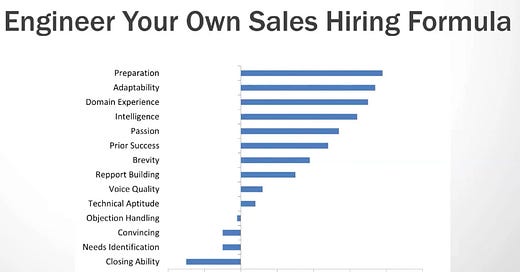🌊 Founder Reads: The Sales Acceleration Formula
How they got to scalable, predictable revenue growth
👋 Hello! I’m Ivan. Join 6.6K entrepreneurs surfing startup waves. Master the best of what other founders and investors have already figured out in under 3’, once a month.
Summary
📈 Hubspot’s playbook: on scalable, predictable revenue growth.
💡 Thinking: writing as a recruiting cheat-code.
💵 Iberian Deals: 14 startup deals in Spain (>€50M).
📈 Hubspot’s 0-$100M Sales Playbook
Mark Roberge scaled Hubspot’s customer base from 0 to 12.000, and from 0 to $100M in revenue between 2007 and 2013.
Even though Mark came from a technical background (MiT Engineer), he was given a sales hat upon joining Hubspot as employee #3 (first sales job he ever had).
He wrote a remarkable playbook - The Sales Acceleration Formula. In it he lays out the 4 formulas he followed to achieve his mission.
What I love about this book is how he rejects the conventional wisdom that sales is more art than science. Most sales books focus on the “art of convincing” buyers.
This book does a 180 and presents the “science” of sales growth - basically a standardised and repeatable process built on tracking and experimentation.
The 4 main actionable “formulas” are a collection of repeatable processes, metrics, and calculations used to complete their mission of generating predictable scale:
Hiring: “Hire the same successful salesperson every time.”
Training: “Train every salesperson in the same way.”
Management: “Hold our salespeople accountable to the same sales process.”
Demand Generation: “Provide our salespeople with the same quality and quantity of leads every month.”
Technology & Experimentation: “developing a culture of experimentation.”
Let’s break it down a little further in case you want to action it.
1. The Sales Hiring Formula
“Hire the same successful salesperson every time.”
Key Idea: The ideal sales hiring formula is different for every company, but the process to engineer the formula is the same.
Data is king
The first year, Mark wrote down the 10 primary criteria he thought would correlate positively to successful sales hiring.
They defined what a score of a 1 to 3, or a 5 to 7, or an 8 to 10 would look like.
They were disciplined about scoring every single hire against that criteria.
Once 6-12 hires had been closed and they were able to assess their performance - they ran analyses to see what correlated to hiring success.
Here’s a regression analysis they ran in 2009 - which they used to continuously improve and refine their Candidate Assessment criteria:
The conclusion was fascinating: people misunderstood what “good sales skills” were - at least in Hubspot’s case.
When looking at the data, they saw:
“Traditional sales skills” (think car sales cliché) such as closing ability, convincing and objection handling, were negatively correlated with success.
And things that you would associate with a great consultant or a coach, like preparation, domain experience, and intelligence were highly correlated.
“This was some form of statistical proof that buyers wanted a different type of salesperson that was less the person that was jamming concepts down your throat, and more someone that they could trust, respect, get advisement from”
2. The Sales Training Formula
“Train every salesperson in the same way.”
Key idea = “A ride-along” (shadowing) training strategy is neither scalable nor predictable. Most top performing sales people succeeed in their own way. You must train salespeople to align with the modern buyer.
Sales = helpful thought leaders
Sales as a profession has traditionally been grossly misunderstood.
If you ask anyone on the street, especially in Spain, what a sales person does - they will likely think something along the lines of “greedy, manipulative, charlatan”.
In modern, data-driven, sales organisations - nothing could be further from that version.
These are supposed to be helpful thought leaders that can prescribe the right solutions to different - often highly complex - business problems.
Not to mention that sales as a skill is often not only present but dominant in most high-level executive positions across many professions including consulting, investment banking, practicing law and so on.
So, how do you train sales teams in today’s world?
Credibility & empathy wins: put your sales-reps into your prospects shoes
Here’s how to think about it. Imagine you have 2 top performers:
Adam: is great at generating tons of activity, mediocre at everything else.
Jen: is great at building rapport, mediocre at everything else.
What would happen if Jen was trained shadowing Adam? She’d fail.
There are 2 things Hubspot did to take advantage of their learnings following the hiring formula (remember, their targets valued a great coach/consultant > car salesman):
Train salespeople to live in their prospect’s world: they spent a good deal of their 30 day training building their own website, blog, social media of 100+ followers, set up seo, landing pages and a/b tests, email following and nurturing, analytics platform etc - and by the time they were done with the training, they felt comfortable talking the prospect’s “language”.
Build their own personal brand: participating online, where prospects were actually conversing. They would read blogs that prospects were spending time on and comment on them. They would figure out what Linkedin groups they were a part of, and answer questions thoughtfully. They’d follow them on twitter, and add value to their conversations.
3. The Sales Management Formula
“Hold our salespeople accountable to the same sales process.”
Key idea = the best sales managers are really great coaches.
Bad Vs Good Coach
A bad sales coach will see 90+ things broken with a new recruit, and spill out the 90+ things this person needs to fix.
A good sales coach sees the same 90+ broken things BUT focuses on the 1 or 2 highest leverage areas. They use metrics to diagnose and address these.
Instead of overwhelming a sales person with a flood of advice on different areas, you should track their productivity and diagnose specific issues.
Here’s a quick example - say you are coaching Mr. Purple below. Based on this data, what would your diagnosis be on what this rep should focus on?
A few things stand out:
Mr. Purple is great a generating leads
Mr Purple has a big dropoff between leads worked and demos delivered.
Finally, Mr. Purple doesn’t generate a lot of revenue.
Bad coach’s diagnosis would have likely been “this person has an activity problem”.
Good coach would use a data-driven approach to diagnose the right problem:
Lets start by prioritizing higher up in the funnel: lead-to-demo step.
Lets “peel back the onion” for more insight. We’re going to see either:
Mr. Purple is working lots of leads, but not getting them on the phone.
Mr. Purple does a bad job at, once connected, pushing them to a demo stage.
Lets say in this case we see that they are in fact just deficient at pushing them to the demo stage once on the phone with them. The coach would therefore - having identified the RIGHT problem - take targeted action on that area such as listening in on the connect calls, how they break the ice, build trust etc.
4. The Demand Generation Formula
“Provide our salespeople with the same quality and quantity of leads every month.”
Key ideas = 1. Inbound is beautiful 2. “journalists” hold the key to the future of demand generation. 3. Use an SLA to solve the Sales-Marketing Alignment problem.
Inbound is beautiful & Jounralists rock&roll
Hubspot’s 2nd marketing hire was a journalist from the New York Times. Why?
They believe there is a tremendous amount of value in the skill of extracting, sharing and synthesising complex ideas into layman’s terms - which played an enormous role in their demand generation formula.
They hired one and followed these steps:
Coupled this person with a few dozens thought leadership folks.
They sat down once a week for an hour, interviewed them and produced a five-page ebook, that turned into three or four blog posts, and a few dozen social media messages that they scheduled over the course of a month.
These pointed back to the relevant blog articles. At the end of each blog article you’d have a call to action that wrote: “Did you like this blog article on XYZ? Perhaps you'd like the free five-page ebook that we wrote. We just need your name, phone number, email address, and company, and you can have it.”
This simple process didn't put a big burden on the executive leadership team, or the sales or engineering teams - and generated a nice stream of quality leads for sales.
The Sales & Marketing SLA is awesome
The reality is that both these teams are rarely really aligned.
Another good idea: learn from Hubspot’s Sales & Marketing SLA.
They essentially put marketing on a revenue quota, just like sales - by focusing their deliverables to sales in the form of Lead Value (instead of number of leads).
Lead value is simply their own calculation of how much value, considering the type of interaction, intent, conversion rate and revenue per customer (based on personas) - each type of lead would generate.
To avoid misalignment (i.e. imagine your SLA = 100 leads per quarter per rep, of any kind) - they calculated lead value and switched their SLA metric to total lead value (i.e. XK of lead value passed on to a sales rep).
Sales is also equally accountable.
First, they calculated what behavior would empower them to make the most money:
As you can see, for HubSpot at the time:
Small business: peaks around 5 sales attempts
Medium business: peaks around 8 sales attempts
Enterprise: peaks around 12 sales attempts.
They then programmed this into the CRM, and each night they’d get a report to see that nothing had fallen through the cracks - optimizing the lead flow automatically.
This report would go out to the CEO and both sales & marketing teams.
This way, they ensured:
The team was following a data-driven methodology they could iterate on.
Make sure marketing was feeding the right demand to the team.
Make sure that that demand was being acted on appropriately by sales.
5. Technology & Experimentation
Develop a culture of experimentation.
Key ideas: Have a look at the previous Startup Riders editions on 🌊 Culture of Experimentation and the 🌊 Sales Tech Stack.
💡 Thinking
People who think well, write well.
Asking someone for 3 pieces of previous written work is basically a recruiting cheatcode. I’m surprised at how little this is used in recruiting processes.
Here are David Ogilvy’s - “Father of Advertising” - 10 commandments on writing well:
💵 Iberian Deals
You love startups and want to enjoy a Spanish lifestyle? Come join the Spanish startup ecosystem. Here’s a list of recently funded startups:
Wooptix (imaging) raised 10M
Cimico (biotech) raised 7M
ZoomAgri (CV/agrotech) raised 6M
Vega Chargers (energy) raised 5M
Orikine (biotech) rasied 5M
Trebellar (proptech) raised 3M
Algori (data) raised 3M
Safeloc (locatoin) raised 2M
Dental Residency (medtech) raised 2M
Hoop (carpool) raised 1.5M
Ucademy (edtech) raised 1M
Newe (logistics) raised 1M
Hotelverse raised 1M
Flowww (saas) raised 1M
P.s. If you enjoyed this, I’d super appreciate a quick share on twitter or Linkedin 🙏
Thank you! 🤙


















Very interesting Ivan, thank you for sharing
🙌🏻